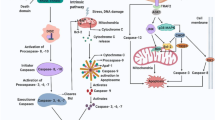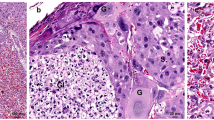Summary
Electron microscope studies of rat embryos were performed from the 7th to 10th days of pregnancy. The single-layered visceral yolk entoderm is characterized by a marked endocytotic activity. The cells of the parietal layer lie separately adjacent to the Reichert's membrane and they contain mainly rough endoplasmic reticulum. The Reichert's membrane consists of a loose network of fine filaments. In the antimesometrial and lateral sites only few trophoblast cells are seen to be attached to the membrane. Between them we find large gaps. With the exception of the mesometrial pole, the embryo is surrounded by a periembryonal sinus, 10–50 μ wide, which contains maternal blood. This sinus space is sealed tightly (zonulae occludentes) by trophoblast and decidual cells. From these findings it was concluded: 1. Reichert's membrane is formed from the parietal jolk sac entoderm. 2. The porous Reichert's membrane permits the maternal plasma to reach freely the visceral jolk sac entoderm. This membrane is the only continuous layer between blood and egg cylinder. 3. By the endocytotic and lysosomal system, the visceral jolk sac entoderm absorbs the plasma coming from the mother. This plasma is degraded and used for the growing embryo. 4. From the immunobiological point of view the antibodies from the mother can reach the embryo freely, 5. The embryonal antigens cannot reach the maternal circulation because of the presence of a decidual barrier, 6. The perimebryonal sinuses are blind sacs into which the maternal blood can flood but it cannot return.
Zusammenfassung
Rattenkeime des Schwangerschaftstages 7–10 wurden elektronenmikroskopisch untersucht. Das viscerale einschichtige Dottersackentoderm zeichnet sich durch eine ausgeprägte endocytotische Aktivität aus. Die Zellen des parietalen Blattes dagegen liegen isoliert der Reichertschen Membran innen an und enthalten vorwiegend rauhes endoplasmatisches Reticulum. Die Reichertsche Membran besteht aus einem lockeren Maschengitter feiner Filamente. Im antimesometrialen und lateralen Bereich haften nur wenige Trophoblastenzellen dieser Membran von außen an, dazwischen befinden sich weite Lücken. Zum mütterlichen Gewebe hin wird der Keim mit Ausnahme des mesometrialen Poles von einem bis zu 50 μ breiten periembryonalen Sinus umgeben, der mütterliches Blut enthält. Nach außen wird dieser Raum durch Trophoblasten- und Deciduazellen abgedichtet. Aus diesen Befunden wird geschlossen: 1. Die Reichertsche Membran wird vom parietalen Dottersack-Entoderm gebildet. 2. Mütterliches Blutplasma kann frei das viscerale Dottersack-Entoderm erreichen, da als einzige kontinuierliche Schicht zwischen Blut und Träger nur die weitmaschige Reichertsche Membran vorhanden ist. 3. Durch das endocytotische und lysosomale System des visceralen Dottersackentoderms wird das anströmende mütterliche Plasma aufgenommen, abgebaut und für den wachsenden Keim nutzbar gemacht. 4. Immunbiologisch betrachtet können Antikörper der Mutter den Keim erreichen. 5. Embryonale Antigene dagegen erreichen durch die Errichtung einer Deciduabarriere nicht den mütterlichen Kreislauf. 6. Der periembryonale Sinus stellt einen Blindsack dar, in den zwar mütterliches Blut einströmen kann, ein Ausstrom aber nicht mehr möglich ist.
Similar content being viewed by others
Literatur
Amoroso, E. C.: Placentation, Kapitel 15, 267. In: Marshall's Physiology of reproduction, ed. by A. S. Parkes, London: Longmans 1952.
Billington, W. D.: The invasiveness of transplanted mouse trophoblast and the influence of immunological factors. J. Reprod. Fertil. 10, 343–352 (1965).
Birbeck, M. C., Mercer, E. H.: Cytology of cells which synthesize protein. Nature (Lond.) 189, 558 (1961).
Bonting, C. L., Bruin, H. de, Pollack, V. E.: Quantitative histochemistry of the nephron. IV. Hydroxyproline in the human glomerulum. J. clin. Invest. 40, 177–180 (1961).
Bradbury, S., Billington, W. D., Kirby, D. R., Williams, E. A.: Surface mucin of human trophoblast. Amer. J. Obstet. Gynec. 104, 416–418 (1969).
Brambell, F., Perry, J.: The development of the embryonic membranes of the shrew, Sorex araneus Linn. and Sorex minutus Linn. Proc. Zool. Soc. Lond. 115, 251–275 (1945).
Brent, R. L.: Antibodies and malformations. In: Advances of biosynthesis 6. Oxford: Pergamon; Braunschweig: Vieweg 1970 (im Druck).
Bruchhausen, F. v., Merker, H. J.: Gewinnung und morphologische Charakterisierung einer Basalmembranfraktion aus der Nierenrinde der Ratte. Naunyn-Schmiedebergs Arch. exp. Path. Pharmak. 251, 1–12 (1965).
——: Morphologischer und chemischer Aufbau isolierter Basalmembranen aus der Nierenrinde der Ratte. Histochemie 8, 90–108 (1967).
Caro, L. G., Palade, G. E.: Protein synthesis, storage and discharge in the pancreatic exocrine cell. An autoradiographic study. J. Cell Biol. 20, 473 (1964).
Cohn, Z. A., Fedorko, M. E.: The formation and fate of lysosomes. In: Lysosomes in biology and pathology, vol. 1, p. 43–63, ed. by J. T. Dingle, and H. B. Fell. Amsterdam-London: North Holland Publ. Comp. 1969.
Currie, G. A., Bagshawe, K. D.: The masking of antigens on trophoblast and cancer cells. Lancet 1967 I, 708–710.
—, Doorninck, W., Bagshawe, K. D.: Effect of neuraminidase on the immunogenicity of early mouse trophoblast. Nature (Lond.) 219, 191–192 (1968).
Dempsey, E. W.: Electron microscopy of the visceral yolk sac epithelium of the guinea pig. Amer. J. Anat. 93, 331 (1953).
Dickson, A. D.: Trophoblastic giant cell transformation of mouse blastocysts. J. Reprod. Fertil. 6, 465–466 (1963).
Dische, R. M., Pappas, G. D., Grauer, A., Dische, Z.: The carbohydrates of basement membranes of human kidney glomeruli. Biochem. biophys. Res. Commun. 20, 63–70 (1965).
Duve, C. de: The lysosomes in retrospect. In: Lysosomes in biology and pathology, vol. 1, p. 3–42, ed. by J. T. Dingle and H. B. Fell. Amsterdam-London: North Holland Publ. Comp. 1969.
Duve, C. de, Wattiaux, R.: Functions of lysosomes. Ann. Rev. Physiol. 28, 435–507 (1966).
Enders, A. C.: A comparative study of the fine structure of the trophoblast in several hemochorial placentas. Amer. J. Anat. 116, 29–68 (1965).
—, Schlafke, S.: A morphological analysis of the early implantation stages in the rat. Amer. J. Anat. 120, 185–226 (1967).
——: Cytological aspects of trophoblast-uterine interaction in early implantation. Amer. J. Anat. 125, 1–29 (1969).
Farquhar, M. G., Palade, G. E.: Functional complexes in various epithelia. J. Cell Biol. 17, 375–412 (1963).
Fawcett, D. W.: The development of mouse ova under the capsule of kidney. Anat. Rec. 108, 71–91 (1950).
Ferm, V. H.: Permeability of the rabbit blastocysts to trypan blue. Anat. Rec. 125, 745–760 (1966).
Finn, C., McLaren, A.: A study of early stages of implantation in mice. J. Reprod. Fertil. 13, 259–267 (1967).
Gekle, D., Merker, H. J.: Neue Vorstellungen über Struktur und Funktion der glomerulären Basalmembran der Niere. Klin. Wschr. 44, 1217–1224 (1966).
Gould, B. S.: Collagen biosynthesis at the ribosomal level. In: Internat. Rev. Conn. Tissue Res., vol. 4, p. 35–67, ed. by D. A. Hall. New York-London: Acad. Press 1968.
Jolie, W. P.: Fine structural changes in the junctional zone of rat placenta with increasing gestational age. J. Ultrastruct. Res. 12, 420–438 (1965).
—: Changes in the fine structure of the parietal yolk sac. Amer. J. Anat. 122, 513–532 (1968).
Kefalides, N. A.: Isolation and characterization of alveolar basement membrane. Clin. Res. 14, 444–449 (1966).
Kirby, D. R. S.: The role of the uterus in the early stages of mouse development. In: Preimplanation stages of pregnancy, p. 325–339. Ciba Found. Sympos., ed. by Wolstenholme and M. O'Connor 1965.
—: The immunological consequence of extrauterine development of allogeneic mouse blastocysts. Transplantation 6, 1005–1009 (1968).
Kirby, D. R. S.: The extra-uterine mouse egg as an experimental model. In: Advances in the Biosciences 4, 255–273 (1969). Schering Sympos. on Mechanisms involved in Conception. Pergamon Press und Vieweg-Verlag.
—, Billington, W. D., Bradbury, S., Golstein, D.: Antigen barrier of the mouse placenta. Nature (Lond.) 204, 548–549 (1964).
——, James, D. A.: Transplantation of eggs to the kidney and uterus of immunised mice. Transplantation 4, 713–722 (1966).
—, Cowell, T. P.: Trophoblast-host interactions. In: Epithelial-mesenchymal interactions, ed. by R. Fleischmajer and R. E. Billingham, p. 64–77. Baltimore: Williams & Wilkins Comp. 1968.
Larsen, F. J.: Electron microscopy of the implantation site in the rabbit. Amer. J. Anat. 109, 319–334 (1961).
Lindner, J.: Zur Physiologie und Pathologie der Schleimbildung des Darms. Verh. dtsch. Ges. Pathol. 53, 111–153 (1969).
Litwer, G.: Über die Sekretion und Resorption in den Dottersackentodermzellen bei graviden weißen Mäusen. Z. Zellforsch. 8, 135–152 (1928).
Lloyd, J. B., Beck, F.: The mechanismus of teratogenic action of trypan blue. In: Teratology, ed. by A. Bertelli and L. Donati, p. 145–151. Amsterdam: Excerpta Med. Foundation 1969.
Maunsbach, A. B.: Functions of lysosomes in kidney cells. In: Lysosomes in biology and pathology, vol. 1, p. 115–149 ed. by J. T. Dingle and H. B. Fell. Amsterdam-London: North Holland Publ. Comp. 1969.
Merker, H. J.: Elektronenmikroskopische Untersuchungen über die Fibrillogenese in der Haut menschlicher Embryonen. Z. Zellforsch. 53, 411–430 (1961).
—: Elektronenmikroskopische Morphologie der intestinalen Resorption. Verh. dtsch. Ges. Path. 53, 57–79 (1969).
Miller, F.: Hemoglobin absorption by the cells of the proximal convoluted tubule in mouse kidney. J. biophys. biochem. Cytol. 8, 689–701 (1960).
Miller, F.: Elektronenmikroskopische und histochemische Untersuchungen an den Lysosomen der Niere. Verh. dtsch. Ges. Path. 47, 346–351 (1963).
Mulnard, J. G.: Les propriétés phagocytaires du trophoblaste au cours des premières phases del'ovo implantation chez la souris. Arch. Biol. (Liège) 78, 575–594 (1967).
Ollerich, D. A., Carlson, E. C.: Ultrastructure of intranuclear annulate lamellae in giant cells of rat placenta. J. Ultrastruct. Res. 30, 411–422 (1970).
Pierce, G. B.: The development of basement membranes of the mouse embryos. Develop. Biol. 13, 231–249 (1966).
—, Midgley, A. R., Sriram, J.: The histogenesis of basement membranes. J. exp. Med. 117, 339–348 (1963).
———, Feldman, J. D.: Parietal yolk sac carcinoma. Clue to the histogenesis of Reichert's membrane of the mouse embryo. Amer. J. Path. 41, 549–566 (1962).
Porter, D. G.: Observations on the development of mouse blastocysts transferred to the testis and kidney. Amer. J. Anat. 121, 73–86 (1967).
Potts, D. M.: The ultrastructure of the implantation in the mouse. J. Anat. 103, 77–90 (1968).
Reinius, S.: Ultrastructure of blastocysts attachment in the mouse. Z. Zellforsch. 77, 257–266 (1965).
Reinius, S.: Light and electron microscopy of Reichert's membrane, endoderm and trophectoderm during early egg implantation in the mouse. J. Ultrastruct. Res. 12, 242–255 (1965).
Rohr, H.: Kollagensynthese in ihrer Beziehung zur submikroskopischen Struktur der Osteoblasten. Virchowa Arch. path. Anat. 338, 342–354 (1965).
Ross, R., Benditt, R. P.: Wound healing and collagen formation. J. Cell Biol. 22, 365–389 (1964).
Satow, Y., Okamoto, N., Fukazawa, K., Ikeda, T., Shimada, K., Imabashi, T.: Electron microscopic observation on the embryos of the 8 the days of gestation in the rats. Hiroshima J. med. Sci. 15, 407–418 (1966).
Schlesinger, M.: Uterus of rodents as site for manifestation of transplantation immunity against transplantable tumors. J. nat. Cancer Inst. 28, 927–945 (1962).
Schwarz, W.: Fibrillogenese und Bildung der elastischen Fasern. Arch. Biol. (Liège) 75, 369–370 (1964/65).
Simmons, R. L.: Intrinsice and extrinsic factors in early mammalian development. In: Advances of biosynthesis 6. Oxford: Pergamon Press; Braunschweig: Vieweg 1970 (im Druck).
Speidel, E., Lazarow, A.: Chemical composition of glomerular basement membrane. Diabetes 12, 355 (1963).
Spors, H.: Unveröffentlichte Befunde aus unserem Institut.
Straus, W.: Cytochemical observations on the relationship between lysosomes and phagosomes in kidney and liver by combining staining for acid phosphatase and intravenously injected horse radish peroxydase. J. Cell Biol. 20, 497 (1964).
Thoenes, W.: Transportwege in den Harnkanälchen der Säugerniere. In: Sekretion und Exkretion. Funktionelle und morphologische Organisation der Zelle, S. 315–342. Berlin-Heidelberg-New York: Springer 1965.
Villegas, H., Merker, H. J.: Electron microscopic observations on cell surface and cell contact in the decidua of rats. (In preparation 1970).
Vollrath, L.: Über Bau und Funktionen von Basalmembranen. Dtsch. med. Wschr. 93, 360–365 (1968).
Wilson, J. G., Shepard, T. H., Gennard, J. F.: Studies on the site of teratogenic action of C14-labeled trypan blue. Anat. Rec. 145, 300 (1963).
Wimsatt, W. A., Wislocki, G. B.: The placentation of the american shrews Blarina Orevicausa and Sorex fumeus. Amer. J. Anat. 80, 361–417 (1947).
Wislocki, G. B., Padykula, H.: Reichert's membrane and the yolk sac investigated by histochemical means. Amer. J. Anat. 92, 117–151 (1953).
Author information
Authors and Affiliations
Additional information
Durchgeführt mit Unterstützung durch die DFG im Rahmen des Sonderforschungsbereiches „Embryonalpharmakologie”.
Rights and permissions
About this article
Cite this article
Merker, H.J., Villegas, H. Elektronenmikroskopische Untersuchungen zum Problem des Stoffaustausches zwischen Mutter und Keim bei Rattenembryonen des Tages 7–10. Z. Anat. Entwickl. Gesch. 131, 325–346 (1970). https://doi.org/10.1007/BF00519974
Received:
Issue Date:
DOI: https://doi.org/10.1007/BF00519974




